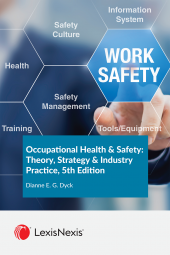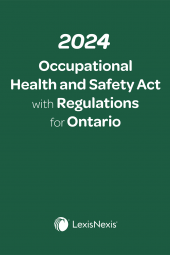Occupational Health & Safety: Theory, Strategy & Industry Practice, 5th Edition
This book equips OH&S practitioners with the information and tools needed to practise ethically, legally, and competently. Learn how to design and implement an effective OH&S Management System and Program.
One Year Subscription Only Terms
Subscribers receive the product(s) listed on the Order Form and any Updates made available during the annual subscription period. Shipping and handling fees are not included in the annual price.
Subscribers are advised of the number of Updates that were made to the particular publication the prior year. The number of Updates may vary due to developments in the law and other publishing issues, but subscribers may use this as a rough estimate of future shipments. Subscribers may call Customer Support at 800-833-9844 for additional information.
Subscribers may cancel this subscription by: calling Customer Support at 800-833-9844; emailing customer.support@lexisnexis.com; or returning the invoice marked 'CANCEL'.
If subscribers cancel within 30 days after the product is ordered or received and return the product at their expense, then they will receive a full credit of the price for the annual subscription.
If subscribers cancel between 31 and 60 days after the invoice date and return the product at their expense, then they will receive a 5/6th credit of the price for the annual subscription. No credit will be given for cancellations more than 60 days after the invoice date. To receive any credit, subscriber must return all product(s) shipped during the year at their expense within the applicable cancellation period listed above.
Product description
Occupational Health & Safety: Theory, Strategy & Industry Practice, 5th Edition is an essential resource for Occupational Health and Safety (OH&S) practitioners and professionals, providing them with the information and tools they need to practise ethically, legally, and competently.
The book guides readers on how to design and implement an effective OH&S Management System and Program, including:
- Who should be involved
- The role of each player
- The legalities and ethics to be considered
- How OH&S relates with other corporate programs
- How to measure and communicate program success or failure
- How to market an OH&S Program
- Sustainability of an OH&S Program
What's New In This Edition
- The latest data and statistics related to OH&S
- Discussion of legal and workplace changes introduced as a result of the COVID-19 pandemic, especially as they relate to the standards for addressing biohazards, emergency response to pandemics, and injury management
- Discussion of the concept of “fit-for-duty”, which has emerged following the legalization of marijuana
Who Should Read This Book
- OH&S practitioners and professionals, as well as other practitioners and health promoters who are responsible for promoting employee health, preventing disease and injury, providing first aid and nursing care, and assisting ill/injured employees with rehabilitation
- Joint health & safety committee members who are charged with facilitating worker health and well-being in the workplace
- Human resources personnel who need to manage and evaluate the performance of OH&S staff and/or administer certain aspects of occupational health and safety such as disability management, benefits, and labour relations
- Management and union leaders who have a vested interest in maintaining workplace health and safety
- Government health and safety departments who need to understand the business aspects of OH&S to develop legislation jointly with industry and union leaders
- OH&S lawyers who must stay current on OH&S legislation, standards, and best practices to represent employers before administrative tribunals and courts
- OH&S professors and students who need a comprehensive textbook, particularly to help prepare for writing the Board of Canadian Registered Safety Professionals Certification Examination (BCRSP)
Contributors
Tony Roithmayr
Heidi Börner
Brett Webb
Ian Arnold
Joti Samra
Mary Ann Baynton
Dan Steinke
Norm Keith
Table of contents
Introduction – Occupational Health and Safety: Theory, Strategy and Industry Practice
Section 1 – Occupational Health and Safety: Theory
Chapter 1 – Occupational Health and Safety: Historical Perspectives
Chapter 2 – Occupational Health and Safety Management Systems
Chapter 3 – Occupational Health and Safety: Key Stakeholders
Chapter 4 – Occupational Health Program
Section 2 – Occupational Health and Safety: Strategies
Chapter 5 – Occupational Health and Safety Program: Manual Development
Chapter 6 – Occupational Health and Safety: Leadership and Commitment (Tony Roithmayr & Dianne Dyck)
Chapter 7 – Safe Workplace = Great Workplace: Building a Sustainable Culture of Safety (Tony Roithmayr)
Chapter 8 – Safety Culture: Safety Climate (Heidi Börner, Dianne Dyck & Brett Webb)
Chapter 9 – Occupational Health and Safety: Hazard Identification, Assessment, and Control
Chapter 10 – New Technology: Impact on the Workplace
Chapter 11 – Occupational Health and Safety: Workplace Standards and Rules
Chapter 12 – Occupational Health and Safety: Emergency Preparedness and Response
Chapter 13 – Occupational Health and Safety: Injury Management
Chapter 14 – Occupational Health and Safety: Incident Investigation
Chapter 15 – Occupational Health and Safety: Risk Management and Communication
Chapter 16 – Marketing Occupational Health and Safety Programs; Communicating the Results
Chapter 17 – Occupational Health and Safety: Worker OH&S Training
Chapter 18 – Occupational Health and Safety: Best Practices
Chapter 19 – Occupational Health and Safety: Supporting Disciplines
Chapter 20 – Occupational Health and Safety: Ergonomics
Chapter 21 – Occupational Health and Safety: Prevention of Workplace Illness and Injury
Chapter 22 – Toxic Work Environments: Impact on Employee Illness/Injury (Tony Roithmayr)
Chapter 23 – Psychological Health and Safety in the Workplace (Ian Arnold, Dianne Dyck & Joti Samra)
Chapter 24 – Psychological Health and Safety: Practical Application in the Workplace (Mary Ann Baynton, Dianne Dyck, Dan Steinke & Tony Roithmayr)
Chapter 25 – Psychological Health and Safety in the Workplace: Measurement (Mary Ann Baynton, Dianne Dyck & Tony Roithmayr)
Chapter 26 – Occupational Health and Safety: Workplace Wellness Strategy
Chapter 27 – Disability Management: Overview
Chapter 28 – Integrated Workplace Health Management
Section 3 – Occupational Health and Safety: Knowledge and Skills
Chapter 29 – Occupational Health and Safety: Ethical Practice
Chapter 30 – Occupational Health and Safety: Legal Aspects
Chapter 31 – Canadian Workplace Safety: Legislation (Norm Keith)
Chapter 32 – OH&S: Legalization of Marijuana: Impact on the Canadian Workplace
Chapter 33 – OH&S: The Canadian Workers’ Compensation System
Chapter 34 – Occupational Health and Safety: Diversity Considerations
Chapter 35 – Impact of Five Generations in the Workplace on Occupational Health and Safety Programs
Chapter 36 – Internal/External Consulting: Tips for Occupational Health and Safety Practitioners/Professionals
Chapter 37 – Occupational Health and Safety: Project Management
Chapter 38 – Occupational Health and Safety: Organizational Behaviour
Chapter 39 – Occupational Health and Safety: Effective Communication
Chapter 40 – Outsourcing Occupational Health and Safety Services
Chapter 41 – Occupational Health and Safety Practitioners/Professionals: Career Development
Section 4 – Occupational Health and Safety: Future Concepts
Chapter 42 – Future Challenges in Occupational Health & Safety
Glossary
Index
 Lexis Nexis
Lexis Nexis 



